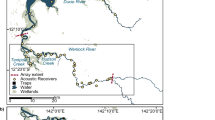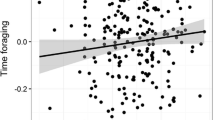Abstract
Recently emerged brook charr (Salvelinus fontinalis) foraging in still-water pools along the sides of streams tend to be either sedentary, feeding from the lower portion of the water column (a sit-and-wait tactic), or very active, feeding from the upper portion of the water column (an active search tactic). We tested whether the individual differences in foraging behavior were associated with baseline concentrations and responses of cortisol, a steroid hormone linked to personality differences in a variety of animals including fishes. We quantified the proportion of time spent on moving by focal charr in the field and then capturing them. Captured individuals were either (i) sacrificed immediately to quantify baseline cortisol concentrations, (ii) held in an unfamiliar field environment for 15 min and then sacrificed to quantify cortisol concentrations in response to handling and holding in a novel field environment, or (iii) held in an unfamiliar field environment with a white Plexiglas base (stressor) for 15 min to quantify cortisol concentrations in response to a novel object. Eleven statistical models relating cortisol concentrations to the proportion of time individuals spent on moving while searching for prey were compared using multi-model inferencing. Cortisol concentrations were higher for charr that spent a lower proportion of time on moving in the field than for charr that spent a higher proportion of time on moving. For a given proportion of time spent on moving, mean cortisol concentrations between baseline and experimental treatments, our measure of cortisol response, did not differ markedly. Our findings suggest that the foraging tactics displayed by wild brook charr in the field could reflect differences in how individuals perceive their environment.


Similar content being viewed by others
References
Archard GA, Earley RL, Hanninen AF, Braithwaite VA (2012) Correlated behaviour and stress physiology in fish exposed to different levels of predation pressure. Funct Ecol 26:637–645
Arterbery AS, Deitcher DL, Bass AH (2010) Divergent expression of 11beta-hydroxysteroid dehydrogenase and 11beta-hydroxylase genes between male morphs in the central nervous system, sonic muscle and testis of a vocal fish. Gen Comp Endocrinol 167:44–50
Barry TP, Malison JA, Held JA, Parrish JJ (1995) Ontogeny of the cortisol stress response in larval rainbow trout. Gen Comp Endocrinol 97:57–65
Baugh AT, van Oers K, Naguib M, Hau M (2013) Initial reactivity and magnitude of the acute stress response associated with personality in wild great tits (Parus major). Gen Comp Endocrinol 189:96–104
Bell AM, Backstrom T, Huntingford FA, Pottinger TG, Winberg S (2007) Variable neuroendocrine responses to ecologically-relevant challenges in sticklebacks. Physiol Behav 91:15–25
Bernier NJ, Alderman SL, Bristow EN (2008) Heads or tails? Stressor-specific expression of corticotropin-releasing factor and urotensin I in the preoptic area and caudal neurosecretory system of rainbow trout. J Endocrinol 196:637–648
Bernier NJ, Flik G, Klaren PHM (2009) Regulation and contribution of the corticotropic, melanotropic and thyrotropic axes to the stress response in fishes. In: Bernier NJ, Van Der Kraak G, Farrell AP, Brauner CJ (eds) Fish neuroendocrinology. Fish physiology. Academic, Burlington, pp 235–311
Biro PA, Stamps JA (2008) Are animal personality traits linked to life-history productivity? Trends Ecol Evol 23:361–368
Biro PA, Stamps JA (2010) Do consistent individual differences in metabolic rate promote consistent individual differences in behavior? Trends Ecol Evol 25:653–665
Bolnick DI, Amarasekare P, Áraujo M, Bürger R, Jiang Y, Levine J, Novak M, Rudolf V, Schreiber S, Urban M, Vasseur D (2011) Why intraspecific trait variation matters in ecology. TREE 26:183–192
Brown C, Jones F, Braithwaite V (2005) In situ examination of boldness–shyness traits in the tropical poeciliid, Brachyraphis episcopi. Anim Behav 70:1003–1009
Burnham KP, Anderson DR (2002) Model selection and multimodel inference: a practical information-theoretic approach, 2nd edn. Springer, New York
Burnham KP, Anderson DR, Huyvaert KP (2011) AIC model selection and multimodel inference in behavioral ecology: some background, observations, and comparisons. Behav Ecol Sociobiol 65:23–35
Carere C, Caramaschi D, Fawcett TW (2010) Covariation between personalities and individual differences in coping with stress: converging evidence and hypotheses. Curr Zool 56:728–740
Carpenter RE, Korzan WJ, Bockholt C, Watt MJ, Forster GL, Renner KJ, Summers CH (2009) Corticotropin releasing factor influences aggression and monoamines: modulation of attacks and retreats. Neuroscience 158:412–425
Dall SRX, Houston AI, McNamara JM (2004) The behavioural ecology of personality: consistent individual differences from an adaptive perspective. Ecol Lett 7:734–739
Dingemanse NJ, Réale D (2005) Natural selection and animal personality. Behaviour 142:1159–1184
Farwell M, McLaughlin RL (2009) Alternative foraging tactics and risk taking in brook charr (Salvelinus fontinalis). Behav Ecol 20:913–921
Ferrari C, Pasquaretta C, Carere C, Cavallone E, von Hardenberg A, Reale D (2013) Testing for the presence of coping styles in a wild mammal. Anim Behav 85:1385–1396
Fuzzen ML, Van Der Kraak G, Bernier NJ (2010) Stirring up new ideas about the regulation of the hypothalamic-pituitary-interrenal axis in zebrafish. Zebrafish 7:349–358
Fuzzen ML, Alderman SL, Bristow EN, Bernier NJ (2011) Ontogeny of the corticotropin-releasing factor system in rainbow trout and differential effects of hypoxia on the endocrine and cellular stress responses during development. Gen Comp Endocrinol 170:604–612
Gilmour KM, Dibattista JD, Thomas JB (2005) Physiological causes and consequences of social status in salmonid fish. Integr Comp Biol 45:263–273
Grant JWA, Noakes DLG (1987) Movers and stayers: foraging tactics of young-of-the-year brook charr, Salvelinus fontinalis. J Anim Ecol 56:1001–1013
Huntingford FA, Andrew G, Mackenzie S, Morera D, Coyle SM, Pilarczyk M, Kadri S (2010) Coping strategies in a strongly schooling fish, the common carp Cyprinus carpio. J Fish Biol 76:1576–1591
Knapp R, Neff BD (2007) Steroid hormones in bluegill, a species with male alternative reproductive tactics including female mimicry. Biol Lett 3:628–631
Koolhaas JM, Korte SM, De Boer SF, Van Der Vegt BJ, Van Reenen CG, Hopster H, De Jong IC, Rusi MW, Blokhuis HJ (1999) Coping style in animals: current status in behavior and stress physiology. Neurosci Biobehav Rev 23:925–935
Koolhaas JM, de Boer SF, Coppens CM, Buwalda B (2010) Neuroendocrinology of coping styles: towards understanding the biology of individual variation. Front Neuroendocrin 31:307–321
McEwen BS (2013) Neuroscience. Hormones and the social brain Science 339:279–280
McLaughlin RL (2001) Behavioural diversification in brook charr: adaptive responses to local conditions. J Anim Ecol 70:325–337
McLaughlin RL, Grant JWA (2001) A field test of perceptual and energetic bases for intermittent locomotion in young brook charr. Behaviour 138:559–574
McLaughlin RL, Grant JWA, Kramer DL (1992) Individual variation and alternative patterns of foraging movements in recently-emerged brook charr (Salvelinus fontinalis). Behaviour 120:286–301
McLaughlin RL, Grant JWA, Kramer DL (1994) Foraging movements in relation to morphology, water-column use, and diet for recently emerged brook trout Salvelinus fontinalis in still-water pools. Can J Fish Aquat Sci 51:268–279
McLaughlin RL, Ferguson MM, Noakes DLG (1999) Adaptive peaks and alternative foraging tactics: evidence of short-term divergent selection for sitting-and-waiting and actively searching. Behav Ecol Sociobiol 45:386–395
Øverli O, Winberg S, Pottinger TG (2005) Behavioral and neuroendocrine correlates of selection for stress responsiveness in rainbow trout—a review. Integr Comp Biol 45:463–474
Øverli O, Sorensen C, Pulman KG, Pottinger TG, Korzan W, Summers CH, Nilsson GE (2007) Evolutionary background for stress-coping styles: relationships between physiological, behavioral, and cognitive traits in non-mammalian vertebrates. Neurosci Biobehav Rev 31:396–412
Pankhurst NW (2011) The endocrinology of stress in fish: an environmental perspective. Gen Comp Endocrinol 170:265–275
Pottinger TG, Carrick TR (1999) Modification of the plasma cortisol response to stress in rainbow trout by selective breeding. Gen Comp Endocrinol 116:122–132
Pottinger TG, Mosuwe E (1994) The corticosteroidogenic response of brown and rainbow trout alevins and fry to environmental stress during a “critical period”. Gen Comp Endocrinol 95:350–362
Price TD, Qvarnstrom A, Irwin DE (2003) The role of phenotypic plasticity in driving genetic evolution. Proc R Soc Lond B 270:1433–1440
Ramsay JM, Feist GW, Varga ZM, Westerfield M, Kent ML, Schreck CB (2009) Whole-body cortisol response of zebrafish to acute net handling stress. Aquaculture 297:157–162
Réale D, Reader SM, Sol D, McDougall PT, Dingemanse NJ (2007) Integrating animal temperament within ecology and evolution. Biol Rev 82:291–318
Réale D, Dingemanse NJ, Kazem AJ, Wright J (2010) Evolutionary and ecological approaches to the study of personality. Philos T Roy Soc B 365:3937–3946
Schjolden J, Backström T, Pulman KGT, Pottinger TG, Winberg S (2005a) Divergence in behavioural responses to stress in two strains of rainbow trout (Oncorhynchus mykiss) with contrasting stress responsiveness. Horm Behav 48:537–544
Schjolden J, Stoskhus A, Winberg S (2005b) Does individual variation in stress responses and agonistic behavior reflect divergent stress coping strategies in juvenile rainbow trout? Physiol Biochem Zool 78:715–723
Schjolden J, Pulman KGT, Pottinger TG, Metcalfe NB, Winberg S (2006) Divergence in locomotor activity between two strains of rainbow trout Oncorhynchus mykiss with contrasting stress responsiveness. J Fish Biol 68:920–924
Sih A, Bell AM, Johnson JC, Ziemba RE (2004) Behavioral syndromes: an integrative overview. Q Rev Biol 79:241–277
Sih A, Cote J, Evans M, Fogarty S, Pruitt J (2012) Ecological implications of behavioural syndromes. Ecol Lett 15:278–289
Skulason S, Smith TB (1995) Resource polymorphisms in vertebrates. Trends Ecol Evol 10:366–370
Skúlason S, Snorrason SS, Jonsson B (1999) Sympatric morphs, populations and speciation. In: Magurran AE, May RM (eds) Evolution of biological diversity. Oxford University Press, New York, pp 79–92
Smith BR, Blumstein DT (2008) Fitness consequences of personality: a meta-analysis. Behav Ecol 19:448–455
Thaker M, Lima SL, Hews DK (2009) Alternative antipredator tactics in tree lizard morphs: hormonal and behavioural responses to a predator encounter. Anim Behav 77:395–401
Thomas P, Robertson L (1991) Plasma cortisol and glucose stress responses of red drum (Sciaenops ocellatus) to handling and shallow water stressors and anesthesia with MS-222, quinaldine sulfate and metomidate. Aquaculture 96:69–86
White JR, Meekan MG, McCormick MI, Ferrari MCO (2013) A comparison of measures of boldness and their relationships to survival in young fish. PLOS ONE 8:e68900
Wilson DS (1998) Adaptive individual differences within single populations. Philos T Roy Soc B 353:199–205
Wilson ADM, McLaughlin RL (2007) Behavioural syndromes in brook charr, Salvelinus fontinalis: prey-search in the field corresponds with space use in novel laboratory situations. Anim Behav 74:689–698
Wilson ADM, McLaughlin RL (2010) Foraging behaviour and brain morphology in recently emerged brook charr, Salvelinus fontinalis. Behav Ecol Sociobiol 64:1905–1914
Acknowledgments
We thank Dr. D.G. McDonald, Dr. F. Leri, R. Dr. Norris, E. Boulding, and two anonymous reviewers for their comments on earlier drafts of this manuscript, J. Zeyl for the assistance in the field and laboratory, R. Frank and M. Cornish for their technical support in Hagen Aqualab, and the Ontario Ministry of Natural Resources (OMNR) for a permit to collect fish. This research was funded by the National Sciences and Engineering Research Council of Canada (RLM and NJB), Canada Foundation for Innovation (RLM), and Ontario Innovation Trust (RLM).
Ethical standards
Our research was conducted in accordance with the Canadian Council on Animal Care guidelines on the care and use of fish in research, teaching, and testing and was approved by the University of Guelph Animal Care Committee (Animal Utilization Protocol no. 04R049).
Author information
Authors and Affiliations
Corresponding author
Additional information
Communicated by D. P. Croft
Rights and permissions
About this article
Cite this article
Farwell, M., Fuzzen, M.L.M., Bernier, N.J. et al. Individual differences in foraging behavior and cortisol levels in recently emerged brook charr (Salvelinus fontinalis). Behav Ecol Sociobiol 68, 781–790 (2014). https://doi.org/10.1007/s00265-014-1691-1
Received:
Revised:
Accepted:
Published:
Issue Date:
DOI: https://doi.org/10.1007/s00265-014-1691-1




